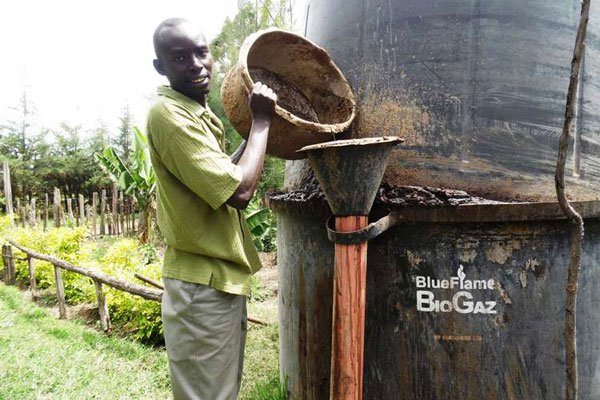Biogas in Kenya: Dominic Nyoro, a fabricator has finally moulded a portable plastic biogas digester for use in peri-urban and rural areas.
“It is a biogas digester like any other,” said Nyoro, who works for Roto Moulders Limited in Nairobi. “The only difference is that this particular one can be moved from one site to another, and can be repaired, unlike the concrete digester, which is permanently planted in an area, and cannot be repaired once it starts leaking.”
The equipment comes in three pieces: A round shaped anaerobic digester tank with an inlet, a displacement tank with an outlet, and the cooker connected using a gas outlet pipe.
“This equipment can be used anywhere including in urban areas, as long as one has access to bio-degradable materials, which include all types of livestock dung, poultry droppings and even food waste,” said Nyoro.
Other materials include vegetable and crop waste, molasses and fruit pulp. The digester can also be used to process water hyacinth, weeds, grass, rice straw, maize stalks, wheat bran and oilseed cakes, among others.
Antony Munuhe from Maradini village, Mukurueini sub-county in Nyeri County is among farmers using the digester.
“I bought one with a capacity of 2,300 litres two months ago, and since then, my family is enjoying cooking with gas,” he said.
Munuhe keeps three dairy cows, and he uses the dung from the animals to produce the biogas. “After the dung is used for producing the gas, I use the slurry on my farm,” he said.
According to Munuhe’s wife Esther Mwihaki, the equipment gives her at least three hours cooking time every day, which is more than enough for preparing all the meals for her family of three children.
Before then, the family depended on firewood for cooking, which Munuhe said had become costly. “A sizeable tree in this area costs up to Sh7,000, yet it cannot sustain cooking for a month,” he said. But with biogas, there is no need to worry as long as it is refilled with bio-degradable materials as required.
For the equipment to produce gas, the digester is filled halfway with bio-degradable materials, like cow dung mixed with water in equal ratio. It is then refilled with smaller amount every two weeks. The equipment starts producing gas after seven days.
Biogas is generally a mixture of different gases produced by bacterial breakdown of organic matter in the absence of oxygen. It is mainly composed of methane, with some carbon dioxide and other trace gases.
Kenya was among the first countries in Africa to adopt biogas technology in the early 1950s.
However, uptake remained low until the Kenya National Domestic Biogas Programme, which is part of Africa Biogas Partnership Programme was rolled out in 2010.
Under the Kenya National Federation of Agricultural Producers as the implementing agency, the country constructed a total of 11,579 against a target of 11, 690 biogas plants between year 2009 and 2013.









How can I get this biogas installed for me and at what cost?
Need one too
I need to be connected
i wish to know more about this and get connected